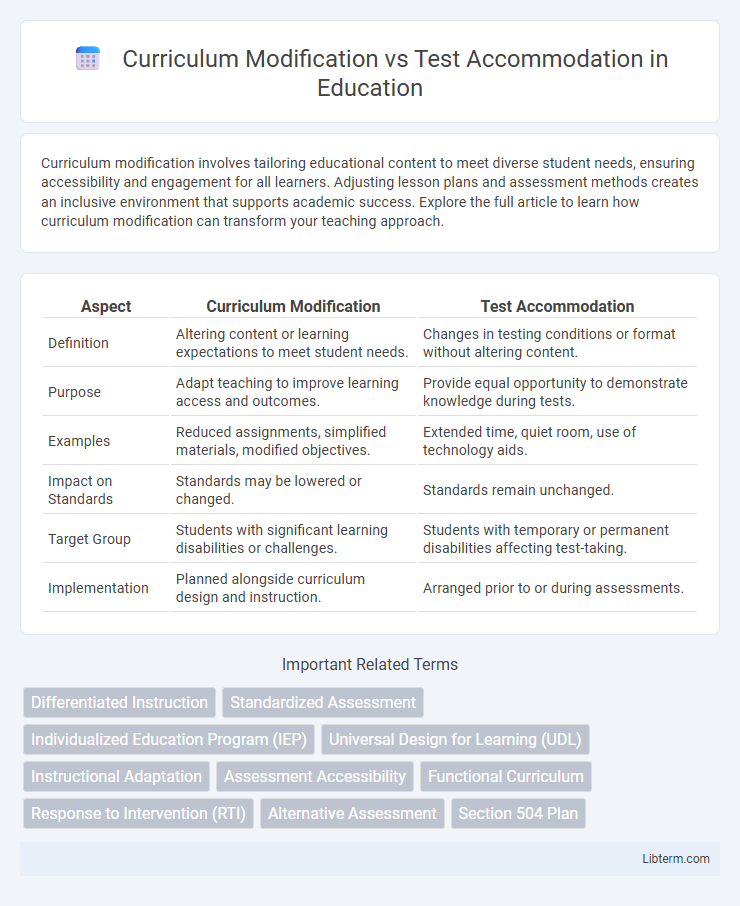Curriculum modification involves tailoring educational content to meet diverse student needs, ensuring accessibility and engagement for all learners. Adjusting lesson plans and assessment methods creates an inclusive environment that supports academic success. Explore the full article to learn how curriculum modification can transform your teaching approach.
Table of Comparison
| Aspect | Curriculum Modification | Test Accommodation |
|---|---|---|
| Definition | Altering content or learning expectations to meet student needs. | Changes in testing conditions or format without altering content. |
| Purpose | Adapt teaching to improve learning access and outcomes. | Provide equal opportunity to demonstrate knowledge during tests. |
| Examples | Reduced assignments, simplified materials, modified objectives. | Extended time, quiet room, use of technology aids. |
| Impact on Standards | Standards may be lowered or changed. | Standards remain unchanged. |
| Target Group | Students with significant learning disabilities or challenges. | Students with temporary or permanent disabilities affecting test-taking. |
| Implementation | Planned alongside curriculum design and instruction. | Arranged prior to or during assessments. |
Introduction to Curriculum Modification and Test Accommodation
Curriculum modification involves altering the content, objectives, or expectations of a course to meet the diverse needs of learners, often by simplifying or changing the material. Test accommodation refers to changes in the administration or format of assessments, such as extended time or alternative settings, allowing students to demonstrate their knowledge without altering the content. Both approaches aim to support student success but differ in whether the curriculum or the testing environment is adjusted.
Defining Curriculum Modification
Curriculum modification involves altering the content, standards, or learning expectations to better suit the individual needs of a student, often by simplifying or reducing the material. Unlike test accommodations that adjust the testing environment or format without changing the curriculum, modifications change what is taught or assessed. Examples include shortened assignments or adjusted learning goals tailored to the student's abilities and learning profile.
Understanding Test Accommodation
Test accommodation refers to changes in the testing environment or procedures that allow students with disabilities to demonstrate their knowledge without altering the test content itself. These modifications include extended time, alternate formats such as Braille, or the provision of a quiet testing area, ensuring equitable access to assessment. Understanding test accommodation is critical for educators to support diverse learners while maintaining the integrity and validity of the evaluation process.
Key Differences Between Curriculum Modification and Test Accommodation
Curriculum modification involves altering the content, expectations, or learning objectives to meet diverse educational needs, while test accommodation adjusts the conditions or format of assessments without changing the curriculum. Curriculum modifications may include reducing the complexity or scope of assignments, whereas test accommodations provide supports such as extended time or alternative test formats to facilitate equitable assessment. Understanding these distinctions ensures students receive appropriate support tailored to their learning profiles while maintaining academic integrity.
Purposes and Goals of Curriculum Modification
Curriculum modification aims to tailor educational content and learning expectations to meet the unique needs of students with disabilities by altering the curriculum's complexity, depth, or pacing. Its purpose is to provide access to grade-level standards in a manner that aligns with individual learning abilities, promoting meaningful engagement and skill acquisition. Unlike test accommodation, which adjusts the testing conditions without changing content, curriculum modification focuses on adapting instruction to ensure comprehensive understanding and academic growth.
Purposes and Goals of Test Accommodation
Test accommodations aim to provide equitable access by adjusting the testing environment or procedures without altering the test content, ensuring students with disabilities can demonstrate their true abilities. Accommodations focus on minimizing barriers related to sensory, physical, or cognitive challenges, thereby maintaining the validity and reliability of assessment results. The primary goal is to create fairness in testing conditions rather than modifying learning expectations or curriculum standards.
Examples of Curriculum Modifications
Curriculum modifications involve altering the content or learning expectations to meet the unique needs of students, such as simplifying reading assignments, providing alternative projects, or reducing the number of homework problems. Examples include replacing a novel with a shorter, more accessible version or allowing students to demonstrate understanding through oral presentations instead of written reports. These modifications differ from test accommodations, which adjust how tests are administered without changing the learning goals, like extended time or preferential seating.
Examples of Test Accommodations
Test accommodations include extended time, alternative test formats such as oral exams or large print, and preferential seating to reduce distractions. Students may also use assistive technology, like speech-to-text software or reading pens, to better demonstrate their knowledge. Such accommodations ensure equitable assessment without altering the curriculum content or learning standards.
Impact on Student Learning and Assessment
Curriculum modification directly alters the content and expectations of a course, which can reshape student learning by providing simplified or alternative materials tailored to individual needs, potentially improving comprehension and engagement. Test accommodations, such as extended time or a quiet environment, adjust the conditions under which assessments are administered without changing the core curriculum, thereby aiming to provide equitable measurement of a student's true knowledge and skills. Both approaches impact assessment outcomes differently: curriculum modifications may affect academic standards, while accommodations strive to minimize external barriers to accurately reflect student achievement.
Choosing the Right Intervention for Diverse Learners
Choosing between curriculum modification and test accommodation depends on the specific needs of diverse learners to ensure equitable access to education. Curriculum modification involves altering the content, teaching methods, or learning expectations to match the student's abilities, while test accommodation adjusts the testing environment or methods without changing the content or standards. Effective intervention requires assessing individual learning profiles and selecting strategies that promote meaningful engagement and accurate assessment of student knowledge.
Curriculum Modification Infographic

 libterm.com
libterm.com